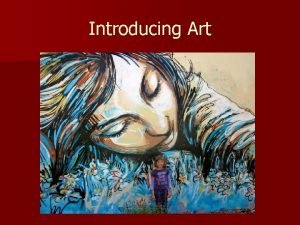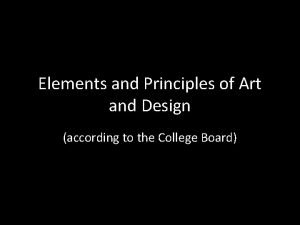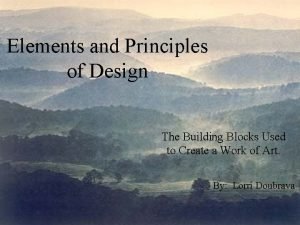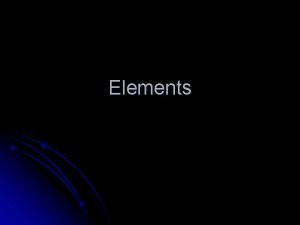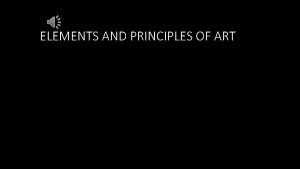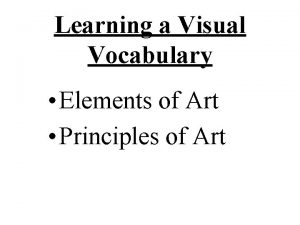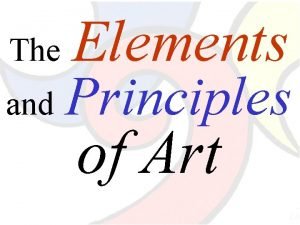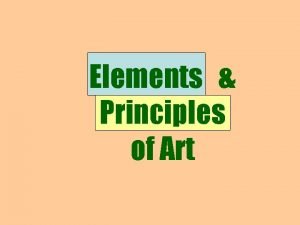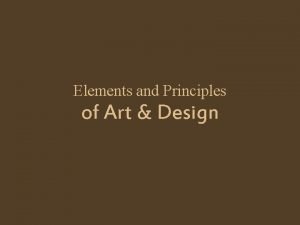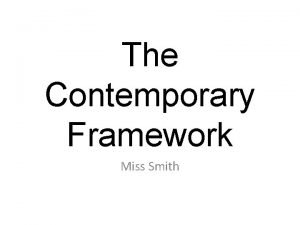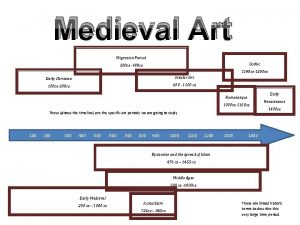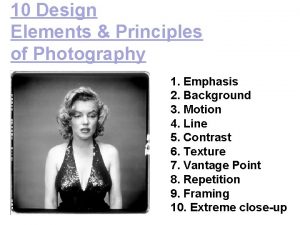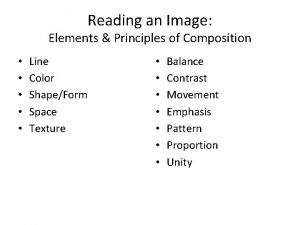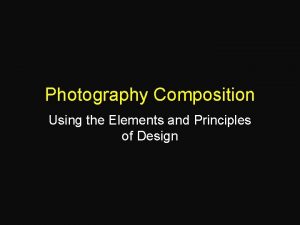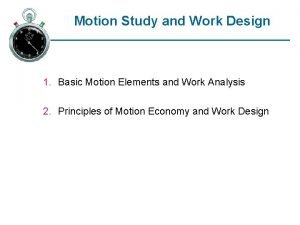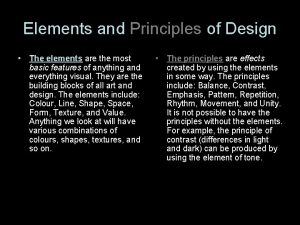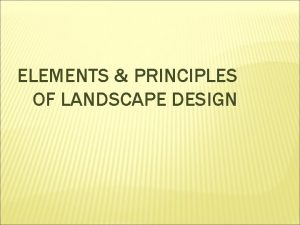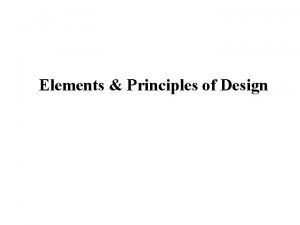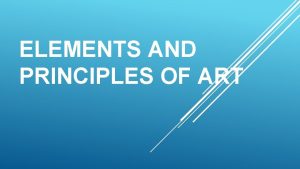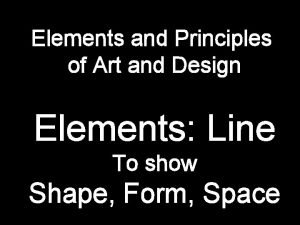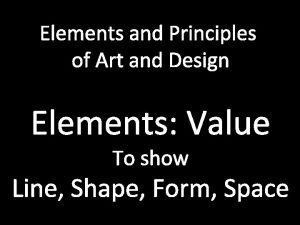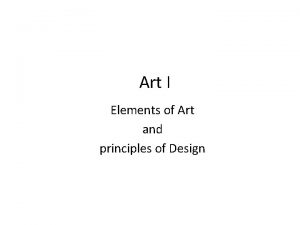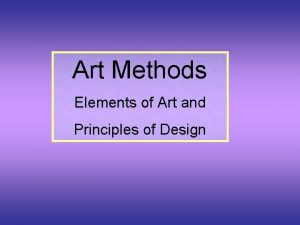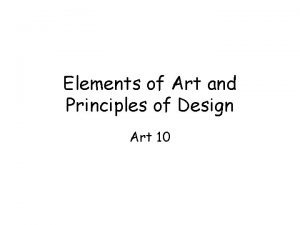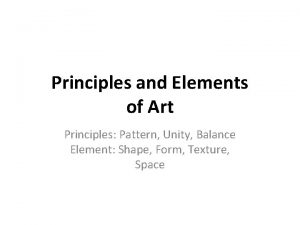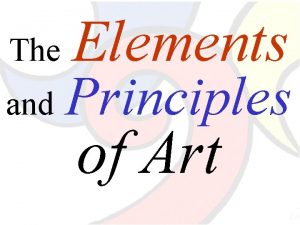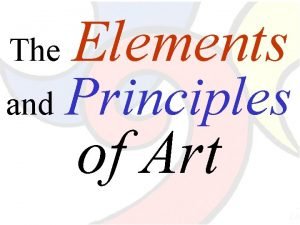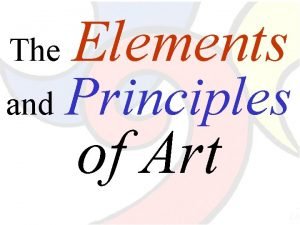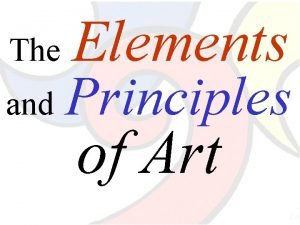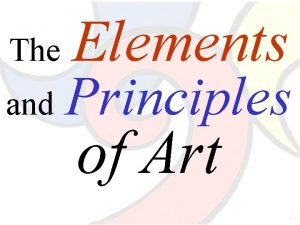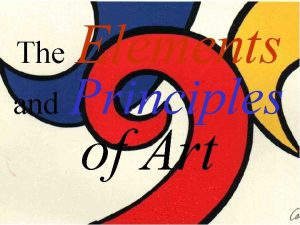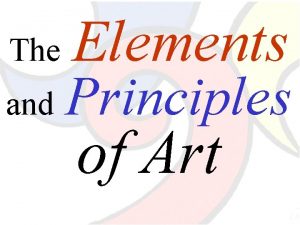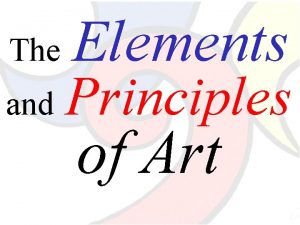Elements The and Principles of Art The Elements
































- Slides: 32

Elements The and Principles of Art

The Elements of Art The building blocks or ingredients of art.

LINE A mark with length and direction. A continuous mark made on a surface by a moving point. Ansel Adams Gustave Caillebotte

Pablo Picasso

COLOR Consists of Hue (another word for color), Intensity (brightness) and Value (lightness or darkness). Henri Matisse Alexander Calder

COLOR Warm and Cool Colors. The color wheel below demonstrates the so-called warm and cool colors. In the upper left half you see the warm colors, yellow, orange, red and the in the lower right half you see the cool colors, green, blue, violet.

Monochromatic is a color scheme using a single hue and adding it’s tint, tone, and shade. Analogous is a color scheme using colors that are adjacent to each other on the color wheel. Complementary is a color scheme using colors that are across from each other on the color wheel. COLOR

COLOR A tint is the mixture of a color with white, which increases lightness, and a shade is the mixture of a color with black, which reduces lightness. A tone is produced either by the mixture of a color with gray, or by both tinting and shading.

VALUE The lightness or darkness of a color. MC Escher Pablo Picasso

SHAPE An enclosed area defined and determined by other art elements; 2 -dimensional. Joan Miro

Natural shapes are created by natural forces not manmade. Organic shapes in art refers to shapes that have less welldefined edges as opposed to geometric shapes. They are generally shapes that are unpredictable and flowing. Shapes Geometric shapes are defined by a set of points or vertices and lines connecting the points in a closed chain, as well as the resulting interior points.

A 3 -dimensional object; FORM or something in a 2 dimensional artwork that appears to be 3 -dimensional. Lucien Freud Jean Arp For example, a triangle, which is 2 -dimensional, is a shape, but a pyramid, which is 3 -dimensional, is a form.

S P A C E The distance or area between, around, above, below, or withings. Claude Monet Robert Mapplethorpe Foreground, Middle-ground and Background (creates DEPTH) Positive (filled with something) and Negative (empty areas).

TEXTURE The surface quality or "feel" of an object, its smoothness, roughness, softness, etc. Textures may be actual (real) or implied (drawn).

Cecil Buller

The Principles of Design What we use to organize the Elements of Art, or the tools to make art.

B A L ANC E The way the elements are arranged to create a feeling of stability in a work. Alexander Calder

Symmetrical Balance Leonardo Da. Vinci The parts of an image are organized so that one side mirrors the other.

Asymmetrical Balance When one side of a composition does not reflect the design of the other. James Whistler

EMPHASIS The focal point of an image, or when one area or thing stand out the most. Jim Dine Gustav Klimt

CONTRAST A large difference between two things to create interest and tension. Ansel Adams Salvador Dali

RHYTHM- Created when one or more elements of design are used repeatedly to create a feeling of organized movement. Marcel Duchamp MOVEMENT: The path the viewer’s eyes take through the work of art, often to focal areas.

Vincent Van. Gogh

PATTERN The repeating of an object or symbol all over the artwork. Gustav Klimt

Repetition • Works with pattern to make the work of art seem active. Rene’ Magritte

UNITY AND HARMONY When all the elements and principles work together to create a pleasing image. Johannes Vermeer

The use of differences and change to increase the visual interest of the work. V AR Marc Chagall IE T Y

P R O P O R T IO The comparative relationship of one part to another with respect to size, quantity, or degree; SCALE. Gustave Caillebotte N

Art Critique • Art Criticism- responding to, interpreting meaning, and making critical judgments about specific works of art. • There are 4 steps to an art critique: – Describe, Analyze, Interpret, Judge

4 Steps: 1. Describe- pure description of the object without value judgments, analysis, or interpretation. "What do you see? " 2. Analyze- determining what the features suggest and deciding why the artist used such features to convey specific ideas. "How did the artist do it? "

4 Steps: 3. Interpret- establishing the broader context for this type of art. "Why did the artist create it and what does it mean? ” 4. Judge- giving it rank in relation to other works and of course considering a very important aspect of the visual arts; its originality. “Is it a good artwork? ”

Vincent Van. Gogh
 Elements and principles of art
Elements and principles of art The relative thickness or thinness of a line is known as
The relative thickness or thinness of a line is known as Elements and principles of art
Elements and principles of art Principle of variety
Principle of variety Principles of art movement
Principles of art movement Da vinci
Da vinci Basic elements of musical play/theatre
Basic elements of musical play/theatre Visual vocabulary art
Visual vocabulary art What is principle of art
What is principle of art Elements principles of art
Elements principles of art Principles of art
Principles of art Element and principles of art
Element and principles of art Contemporary framework art
Contemporary framework art What is high art and low art
What is high art and low art Migration period art
Migration period art Elements of hair design
Elements of hair design Elements of hair design
Elements of hair design Elements floral design
Elements floral design Principles and elements of design chart
Principles and elements of design chart Elements and principles of design ppt
Elements and principles of design ppt Visual design principles and elements matrix
Visual design principles and elements matrix Dtp elements
Dtp elements Photos that show emphasis
Photos that show emphasis Elements and principles of composition
Elements and principles of composition The area used or unused in a composition
The area used or unused in a composition Basic motion
Basic motion Ci elements
Ci elements Postmodern principles of art
Postmodern principles of art Elements and principles of design space
Elements and principles of design space Mona lisa elements and principles
Mona lisa elements and principles Elements of design architecture
Elements of design architecture Elements and principles of landscape design
Elements and principles of landscape design What are the elements and principles of design
What are the elements and principles of design
